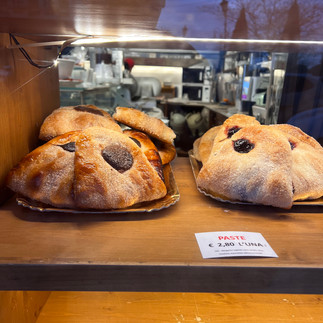Week 2 Reflection
- Autumn Lamb

- Jan 12, 2024
- 3 min read
Updated: Oct 1
This week encompassed a wide range of human emotions. From joy and excitement, to accomplishment, to sadness and grief. From coffee to the Pantheon and course work, there was a little bit of everything mixed together.
One fun highlight included daily stops at the café and the entire experience in Italian. Even with my limited knowledge of Italian, being able to order different types of coffees, croissants, and pastries, and pay using Italian and not relying on the staff to switch to English feels like a major accomplishment. I am not able to hold a conversation yet outside of the ordering and paying, but that’s ok. And can I just tell you, the café bar culture of Rome is fantastico!! It is nothing like US coffee culture. Seattle is a coffee town, with its own distinct coffee culture. And Rome is a café town, with its own distinct coffee culture. I think I’ll make a separate post all about coffee to showcase different types, how to order and enjoy, etc.
In our “colonization, assimilation, and slavery in ancient and medieval Rome” course, we began discussing various monuments around the city. Rather than just looking at them as tourists, we learned about their origins, layers of functions and purposes over the centuries and millennia and began to shift our framework of viewing these built structures. Questions such as who built this, why was it originally built, why was it chosen to remain while others were torn down, and what function does it serve today? These are multi-layered questions, and the answers reflect the millennia that encompass their existence.
One such structure we visited this week is the Pantheon. Originally built by Agrippa between 25 and 27 BC, this structure was dedicated to all the gods and served as a space of worship. At the time, it was believed that when powerful rulers died, they became like a god, so structures built would be dedicated to these rulers. Agrippa didn’t want to be worshipped as a god, which is why the structure is called the Pantheon and was dedicated to all the gods. Over the centuries some elements were removed to build other structures around the city, showing shifting priorities and influences of power. With the rise of the Catholic church beginning in the 300’s, many pagan structures were destroyed, and their materials used for other buildings. Surprisingly the Pantheon was not destroyed, though materials were taken for other structures. I found it interesting that now the structure is an active church with images of Mary and Christ that are worshipped, and no longer a pagan structure.
Inside the building was spectacular. It was the first of its kind with the domed ceiling, and its engineering influence can be seen around the world, from the roofs of Duomos throughout Europe, the White House in the US, and many more buildings. Ancient Romans were students of astronomy and numerology, and this knowledge can be seen throughout the building, from the hole in the ceiling that allows light in which shines through the front entrance on the anniversary of the founding of Rome, to the measurements of the ceiling and floors. Layers upon layers of numerical significance are found in the building. Books upon books of information can be read to dig further into this one ancient structure in Rome.
Course work this week was as important as learning how to approach monuments, but more difficult to wrestle with. We are starting our refugee and forced migration studies by looking at disasters that create situations where people must flee their home. There is simply nothing easy about reading and watching footage of civil war, political revolution, religious revolution, and genocide. Statistics are staggering at the sheer number of disasters that have occurred around the world over the past century alone. When faced with the large numbers, I find myself numbing slightly to the magnitude of displacement and need for assistance around the world.
But numbing does nothing to have any impact on the problem. So, I am attempting to find the story in the numbers. Because the numbers are people, with families, loved ones, and stories unique in their own way. Even when themes emerge such as the type of disaster that people fled from – war, revolution, or genocide – everyone has their own experience within the disaster. It is these stories that I am interested in learning and sharing (as appropriate, and with proper permissions).
Over the next months I will share more of the stories and materials we are learning and will give appropriate trigger warnings so you can choose which posts to read or not read. It is important when engaging with difficult topics and stories to know how to care for your mental and emotional health and engage as you are able.
Until next time,
Ciao!




















Comments